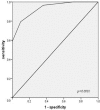Clinical characteristics and outcomes of hypersensitivity pneumonitis: a population-based study in China
- PMID: 31021982
- PMCID: PMC6629344
- DOI: 10.1097/CM9.0000000000000256
Clinical characteristics and outcomes of hypersensitivity pneumonitis: a population-based study in China
Erratum in
-
Corrigendum: Clinical characteristics and outcomes of hypersensitivity pneumonitis: a population-based study in China.Chin Med J (Engl). 2021 Jan 11;134(3):378. doi: 10.1097/CM9.0000000000001158. Chin Med J (Engl). 2021. PMID: 33522730 Free PMC article. No abstract available.
Abstract
Backgrounds: Hypersensitivity pneumonitis (HP) is an immune-mediated interstitial lung disease (ILD) that develops in response to the inhalation of various antigens. The clinical pathologies are very complex and undetermined. The clinical features and outcomes of HP have not been fully elucidated. The aim of this study was to analyze the incidence, clinical features, and outcomes of HP patients and construct a simple clinical model for diagnosing chronic HP (CHP).
Methods: The cohort study included 101 patients with HP admitted to the Nanjing Drum Tower Hospital from January 2009 to December 2017. The patients were categorized into acute HP (AHP, n = 72) and CHP (n = 29) groups according to the updated international criteria. The clinical, imaging, treatment, and follow-up data were retrospectively reviewed. All patients were followed up until December 31, 2017. Statistical analysis was performed, and a clinical scoring system for CHP was constructed by SPSS 20.0 software.
Results: The incidence of HP was 2.4% in ILD inpatients in our center. Patients in the CHP group were older (t = -2.212, P = 0.029), had more smokers (χ = 8.428, P = 0.004), and longer duration of symptoms (t = -4.852, P < 0.001) than those in the AHP group. Weight loss, crackles, digital clubbing, and cyanosis were more common in the CHP group than those in the AHP group (χ = 5.862, P < 0.001; χ = 8.997, P = 0.003; χ = 11.939, P = 0.001; and χ = 4.025, P = 0.045, respectively). On chest high-resolution computed tomography (HRCT), reticular patterns, traction bronchiectasis, and accompanying honeycombing were more common in CHP cases than those in AHP cases (χ = 101.000, P < 0.001; χ = 32.048, P < 0.001; and χ = 36.568, P < 0.001, respectively). The clinical scoring system for CHP was established based on the clinical variables (age [A], duration of symptoms [D], smoking history [S], unidentified exposure [U], and chest HRCT [C]; ADSUC) (area under the curve 0.935, 95% confidence interval: 0.883-0.987, P < 0.001). Eleven patients (15.3%) in the AHP group developed CHP, and unidentified exposure was an independent risk factor for the progression of disease (P = 0.038). The survival of patients with CHP, smoking history, unidentified antigens and fibrosis on Chest HRCT were significantly worse (P = 0.011, P = 0.001, P = 0.005, and P = 0.011, respectively) by Kaplan-Meier analysis. Cox multivariate regression analysis revealed that unidentified exposure and total lung volume (TLC pred%) were independent prognostic predictors for HP patients (P = 0.017 and P = 0.017, respectively).
Conclusions: The clinical features and outcomes of the CHP patients differ from those of the AHP patients. ADSUC is a simple and feasible clinical model for CHP. Unidentified exposure is an independent risk factor for the progression of AHP to CHP. Unidentified exposure and a low baseline TLC pred% are independent predictors for survival in HP patients.
Figures




References
-
- Solaymani-Dodaran M, West J, Smith C, Hubbard R. Extrinsic allergic alveolitis: incidence and mortality in the general population. QJM 2007; 100:233–237. doi: 10.1093/qjmed/hcm008. - PubMed
-
- Madsen D, Klock LE, Wenzel FJ, Robbins JL, Schmidt CD. The prevalence of farmer's lung in an agricultural population. Am Rev Respir Dis 1976; 113:171–174. doi: 10.1164/arrd.1976.113.2.171. - PubMed
-
- Fernandez Perez ER, Kong AM, Raimundo K, Koelsch TL, Kulkarni R, Cole AL. Epidemiology of hypersensitivity pneumonitis among an insured population in the United States: a claims-based cohort analysis. Ann Am Thorac Soc 2018; 15:460–469. doi: 10.1513/AnnalsATS.201704-288OC. - PubMed
MeSH terms
LinkOut - more resources
Full Text Sources
Medical
Research Materials
Miscellaneous

